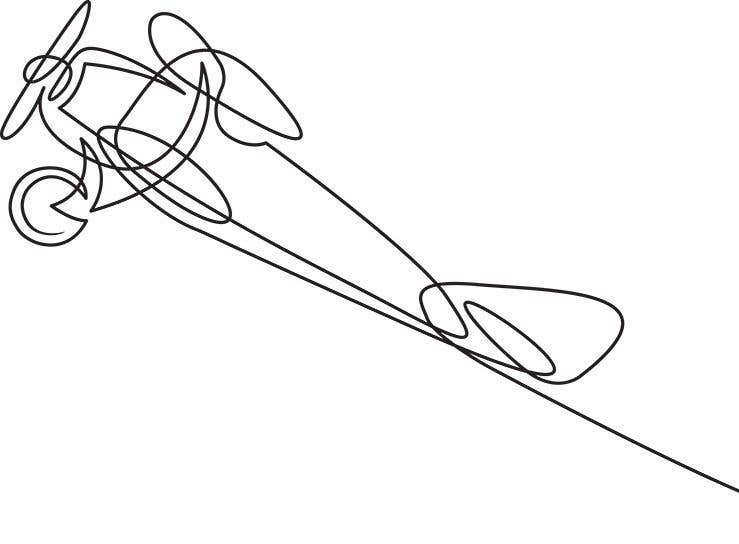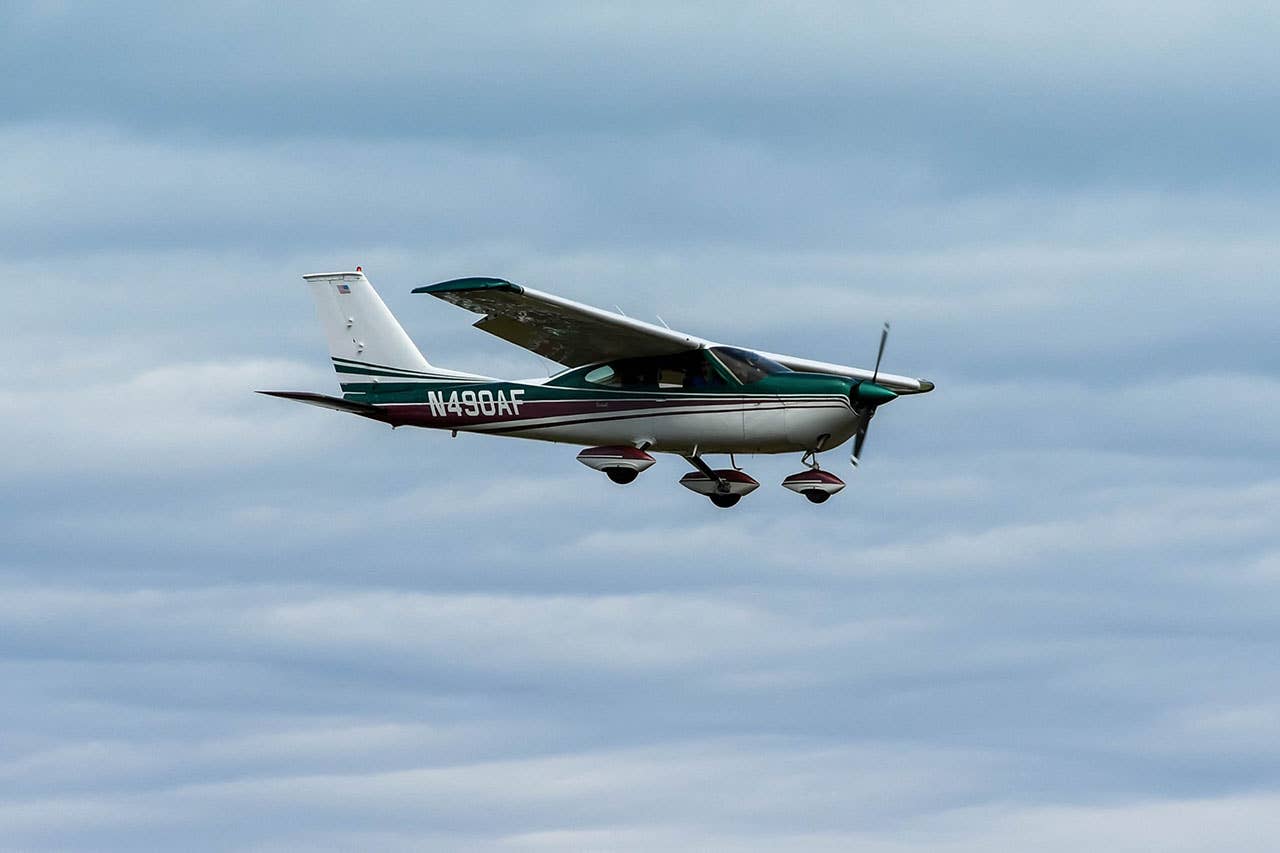Diving Into Your Pilot Proficiency Old School Style
Unplugging for a while can be the best thing you ever did for your aviation knowledge and test prep.

Continuous line drawing of jet plane . Flight biplane Tandem wing. The symbol of take-off in the sky
Following up on the "Rusty Pilot" admonitions offered in the May 2020 issue of Plane & Pilot, we felt this would be an appropriate time to give advice, and hopefully motivation, to encourage brushing up your aviation knowledge after a period of infrequent, or no, flying. If you've been absent from serious aviation for a while, your first inclination is to just strap into a familiar and comfortable airplane and go flying. That might be okay from a motivational standpoint; boring holes in the welcoming air of a nice flying day helps us remember why we're paying the bills and putting up with the regulatory hassles. However, there's a lot more to regaining safe piloting abilities than mere stick work. It's also necessary to crack the books, reviewing procedures and rules. Things have a way of changing in aviation while we're off pursuing other interests.
Now, I know you've kept your Flight Review current. But that requirement only specifies a minimum of one hour of ground instruction, to go along with the basic hour of in-flight reviewing. You had best devote more time than that when you're trying to get current after a long layoff. Legally current and competently current are two entirely different things. Fortunately, you can study up on your own, tailoring a program to your own personal needs.
What To Study
Where to begin? Begin with what interests you, and let that lead you into broader coverage of a related subject that appeals to you. For instance, if you're into owner-maintenance, you can't go wrong with picking up the faithful old Advisory Circular 43.13, "Acceptable Methods, Techniques and Practices." Just leafing through it or scanning down the contents pages is bound to pique your curiosity and cause you to pursue a topic. Or, if you can't wait to get back into the air, looking through the Aeronautical Information Manual is a logical way to review operational procedures. Look for a "latest changes" page or bold-print bracketed words and phrases in the text, which are commonly used to denote changes from previous printings. You'll be surprised what they slip into the AIM when you're not looking.
Spring for a fresh edition of your local Sectional Aeronautical Chart (on paper, for easier studying) and perhaps a Terminal Area Chart, if you're located in or near the confines of a Class B mushroom. Peruse the chart's legend panel and see how many odd symbols and notations have cropped up since you last held a map in your hands. Enlist the aid of a sharp young CFI to help you make sense of the more arcane depictions.
Now, let's get specific about the airplane and equipment. Before I fly any airplane after being away from it for a long time, I delve into as much documentation as I can find on that aircraft. There are operating limitations to check out, cautions and warnings to be observed, and detailed operating guidelines from the manufacturer, all contained in a POH or approved flight manual to show the pilot the recommended (best) way to operate the aircraft. Read this stuff; a lot of work went into developing it, and knowing what those efforts came up with helps keep you out of trouble.
The avionics are as much a part of flying as the airplane in these technically advanced days. You probably just flip the switches and buttons out of habit, but inevitably there will be little nuances you've overlooked because you didn't take time to read all the avionics manuals. You know, those supplements that are supposed to be carried in the airplane at all times, the ones you probably never looked at after the avionics shop finished the installation. Dig them out and read through them; it helps to do this while sitting in the airplane, looking at the radios.
"Begin with what interests you, and let that lead you into broader coverage of a related subject that appeals to you."
In this day and age, you need to be well-informed on the avionics set-up before you attempt to fly. There are a lot of ways to become entangled in audio switching panels, intercoms, headset jacks and frequency storage retrieval. Know how to do a comm check before you blast off into controlled airspace, as well as test the squelch override and volume levels for each radio. Be sure there's a hand microphone or extra headset on board, in case the primary headset goes inop, a jack is intermittent or the push-to-talk won't push. Think about what your work-around options are going to be.
Read every scrap of documentation that can be found pertaining to the airplane, particularly those that apply to the autopilot, STC'd equipment and other add-ons. If you've had an engine upgrade, there should be changed performance charts to cover that enhancement, in addition to the basic operations manual for the aircraft. It's not unusual to find the original design's procedures have been changed by these modifications.
Make notes as you study, writing down important criteria, jotting down the V-speeds to be used for obtaining best performance and the manufacturer's safety tips. Doing so will help reinforce your memory, and you can easily review those notes just prior to flight. Note-taking summarizes the specific points, so you don't have to keep re-reading the material in its entirety.
Know Thy Airplane, Again
Before you ever set foot in an airplane after a layoff, re-learn everything you possibly can about it. You probably think you knew more than anyone else about your familiar old plane's systems and installations. Don't let that opinion fool you into assuming you don't need to review the supplied documents and the unique aspects of this particular airplane. As you preflight, make notes as you go around the aircraft. Have the manufacturer's flight manual in hand, matching descriptions with actual physical features. Sit in the cockpit with the manual on your lap, noting where switches and controls are located and the meaning of their labeling. Accept no unmarked gadgets; put temporary labels on them so you'll know what they do and which way turns them on and off.
While in the cockpit, make sure you can reach everything. If the seat won't adjust sufficiently, obtain the cushions necessary to prop yourself up. See if the belts and harness allow enough reach room to perform all flying duties when tightened. Find out how the canopy or door latches work; some airplanes require a cross-arm maneuver or loosening of a belt to get to the latches.
Pay particular attention to reviewing fuel system operation. A large percentage of aircraft accidents are caused from fuel-related factors because the pilot didn't remember how to manage the gas. You have to know where the fuel is and how to bring a steady supply to the engine. Some older planes use one gauge that must be switched along with the fuel valve to keep the gauge on the tank in use. Sometimes the tanks have to be used in a particular order, like the flip-flop management of early fuel-injected Bonanzas that goes "left main/aux tanks/left main/right main" and then finishes with the left main, where all the excess return fuel went.
Know The Environment
Brush up on the significant terrain features and airspaces you're going to encounter. Perhaps your previous flying took place in another part of the country or was done under TRSA procedures instead of Class B or C. If you're unfamiliar, go over the map with a local pilot you can trust, someone who can point out the useful landmarks and places to avoid. If there are noise-abatement procedures to be followed at some of the local airports, make notes of these extra details, which often aren't shown anywhere except on an airport bulletin board or perhaps are buried in the cryptic runes of the Chart Supplement book.
For every airport, you need to understand which wind directions produce the least turbulence and which way the weather changes arrive from. Some airports won't be usable by your aircraft when the density altitude soars or the wind gusts are too great. If you like to frequent short grass fields, be sure to find out how to check their condition before you go there.
If you haven't been into congested flight-rules airspace lately, get some ground instruction from someone familiar with the area, pointing out the best routes around and through the thicket of busy airport traffic flows and extra-rules airspaces. Practice talking the talk; don't be embarrassed to dry-fly an entry and departure sequence with a CFI playing the part of ATC. You may find that controllers talk faster than they did when you last flew. The more practice you can get, listening to a scanner or a live feed from an online site, the better you'll become at decoding the garble.
When was the last time you went through the regulations and recommended procedures that apply to your operations?
Know The Rules
When was the last time you went through the regulations and recommended procedures that apply to your operations? Did you know that segmented circles around an airport's wind indicator aren't common anymore because right-hand pattern notations are now found on the sectional chart at the bottom of the airport data block? In their absence, left-hand turns for landing are mandatory. Do you know how to go about asking for VFR flight following? Did you know that the AIM recommends against calling out "any traffic in the area, please advise?" Do you know the difference between the announcements of "number two" and "flight of two" in an arrival sequence?
Dry regulatory prose can be sleep inducing, but you can find things you've forgotten buried in there. If you're coming back from a layoff, you might find that the paragraph count has increased from your last reading of the rule book. That's just mission-creep from attempting to cover all types of operations and equipment. For instance, check out the lengthy FAR paragraphs 91.225 and 91.227, which detail the rules for ADS-B. Even the terms can change; our old Flight Standards District Offices (FSDO) are now referred to as just Flight Standards Offices (FSO). When it comes to reviewing the regs, focus on the rules that are applicable to your type of flying. If you're going to be VFR only, below the flight levels, you might skip the pages pertaining to operations that exclude you. It doesn't hurt, however, to know that such flying is going on and how it might impact your use of the airspace.
Ground study may seem like a waste of time when you really want to go up and hone your flying skills, but knowledge is power. The more you know about the airplane, environment and regulations you're going to be involved with, the smoother your transition back to comfortable flying will be. There's nothing worse than an uneasy feeling that you might have forgotten things like how to work the emergency landing gear extension or how to make a request to the tower controller. Study up, then go fly.

Subscribe to Our Newsletter
Get the latest Plane & Pilot Magazine stories delivered directly to your inbox






